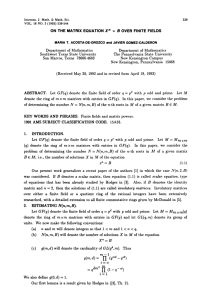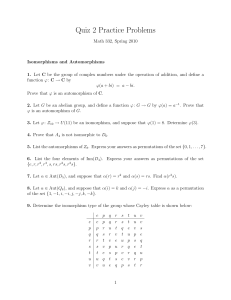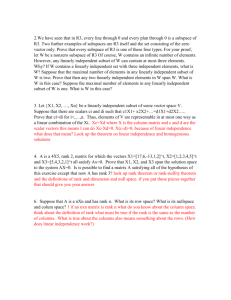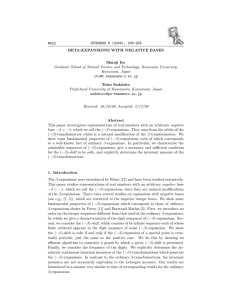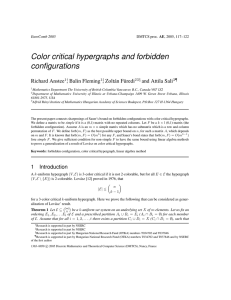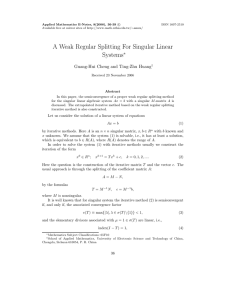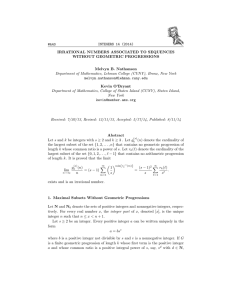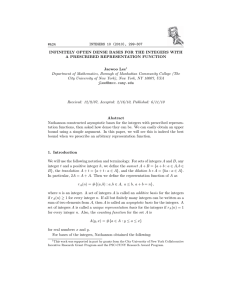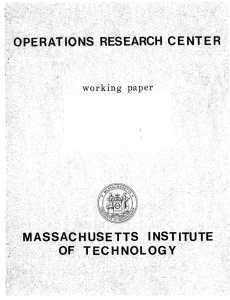Some new Constructions of Optimal Superimposed Designs. Sergey Yekhanin
advertisement
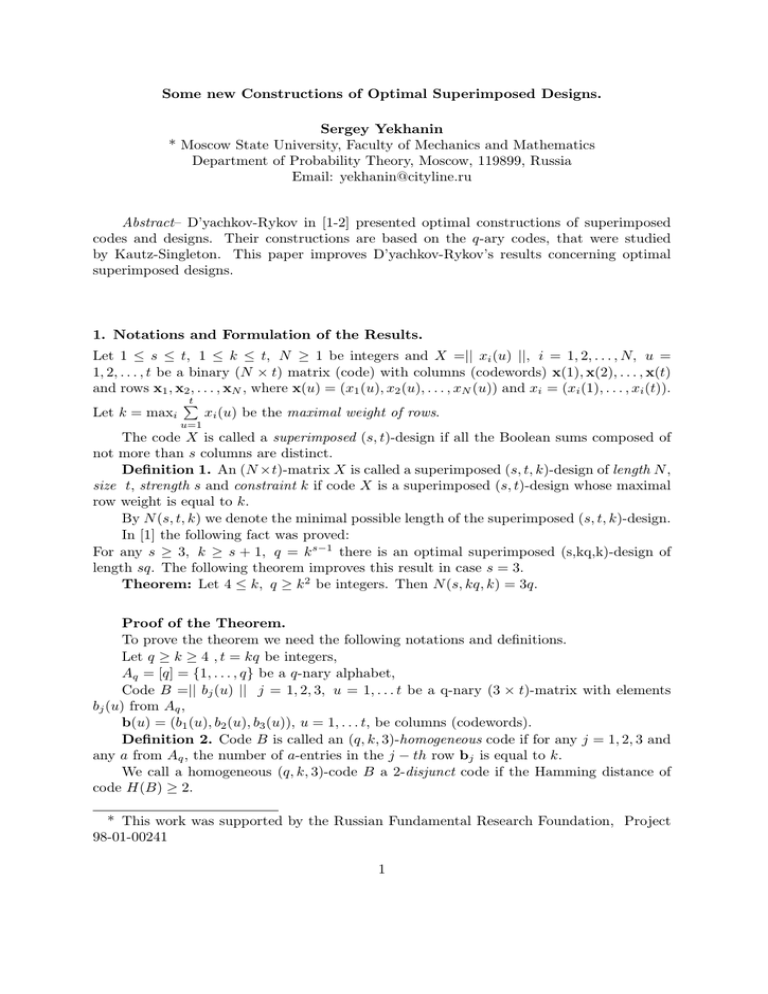
Some new Constructions of Optimal Superimposed Designs.
Sergey Yekhanin
* Moscow State University, Faculty of Mechanics and Mathematics
Department of Probability Theory, Moscow, 119899, Russia
Email: yekhanin@cityline.ru
Abstract– D’yachkov-Rykov in [1-2] presented optimal constructions of superimposed
codes and designs. Their constructions are based on the q-ary codes, that were studied
by Kautz-Singleton. This paper improves D’yachkov-Rykov’s results concerning optimal
superimposed designs.
1. Notations and Formulation of the Results.
Let 1 ≤ s ≤ t, 1 ≤ k ≤ t, N ≥ 1 be integers and X =|| xi (u) ||, i = 1, 2, . . . , N, u =
1, 2, . . . , t be a binary (N × t) matrix (code) with columns (codewords) x(1), x(2), . . . , x(t)
and rows x1 , x2 , . . . , xN , where x(u) = (x1 (u), x2 (u), . . . , xN (u)) and xi = (xi (1), . . . , xi (t)).
t
P
Let k = maxi
xi (u) be the maximal weight of rows.
u=1
The code X is called a superimposed (s, t)-design if all the Boolean sums composed of
not more than s columns are distinct.
Definition 1. An (N ×t)-matrix X is called a superimposed (s, t, k)-design of length N ,
size t, strength s and constraint k if code X is a superimposed (s, t)-design whose maximal
row weight is equal to k.
By N (s, t, k) we denote the minimal possible length of the superimposed (s, t, k)-design.
In [1] the following fact was proved:
For any s ≥ 3, k ≥ s + 1, q = k s−1 there is an optimal superimposed (s,kq,k)-design of
length sq. The following theorem improves this result in case s = 3.
Theorem: Let 4 ≤ k, q ≥ k 2 be integers. Then N (s, kq, k) = 3q.
Proof of the Theorem.
To prove the theorem we need the following notations and definitions.
Let q ≥ k ≥ 4 , t = kq be integers,
Aq = [q] = {1, . . . , q} be a q-nary alphabet,
Code B =|| bj (u) || j = 1, 2, 3, u = 1, . . . t be a q-nary (3 × t)-matrix with elements
bj (u) from Aq ,
b(u) = (b1 (u), b2 (u), b3 (u)), u = 1, . . . t, be columns (codewords).
Definition 2. Code B is called an (q, k, 3)-homogeneous code if for any j = 1, 2, 3 and
any a from Aq , the number of a-entries in the j − th row bj is equal to k.
We call a homogeneous (q, k, 3)-code B a 2-disjunct code if the Hamming distance of
code H(B) ≥ 2.
* This work was supported by the Russian Fundamental Research Foundation, Project
98-01-00241
1
Let e = (e1 , e2 , e3 ) be an arbitrary 3-subset of set [t] = {1, . . . t}. For a given code
B and any j = 1, 2, 3, denote by Aj (e, B)-the set of all pairwise distinct elements of the
sequence bj (e1 ), bj (e2 ), bj (e3 ).
Definition 3. Let n ≤ 3 be arbitrary integer. 2-disjunct code B is called an 3-separable
code if for an arbitrary n-subset e = (e1 , . . . , en ) of set [t], there exists the possibility to
identify this subset on the basis of sets:
A1 (e, B), A2 (e, B), A3 (e, B)
Definition 4. Homogeneous code B is called a 3-hash if for an arbitrary 3-subset
e = (e1 , e2 , e3 ), of the set [t], there exists a coordinate j = 1, 2, 3, such that all the elements
bj (e1 ), bj (e2 ), bj (e3 ) are all different.
Let a symbol b from [q] of (q, k, 3) separable code be replaced by the binary q-sequence
in which all the elements are 0’s, except the element with the number b. As a result we
obtain a binary code XB which is a superimposed design.
Consider an arbitrary (q, k, 3) 2-disjunct code B. We introduce a characteristic (q × q)matrix C with the elements from alphabet Aq+1 = {∗, [q]} = {∗, 1, 2, . . . q}. Where
Cij =
a, if in X there is a codeword (i, j, a);
*, otherwise.
We say that matrix B is identified by the characteristic matrix C which will be called
C(q, k)-matrix.
Matrix C is an C(q, k)-matrix if and only if C has the following properties:
1. For any x from [q] there are exactly k pairs (i, j) such that Cij = x. Hence, there
are q(q − k) ∗ in C(q, k).
2. For any p, i, j from [q] neither Cpi = Cpj 6= ∗ nor Cip = Cjp 6= ∗ where i 6= j. Hence
all the numbers in one column or row are distinct.
3. For any column (row) of C the number of ∗-entries s equal to k.
Denote by CHS (q, k)-matrices of hash&separable code.
It is possible to prove that matrix C is CHS (q, k) if and only if C has the properties
1 − 3 and the following 2 properties.
4. For any i, j, k, p from [q] such that Cij = Ckp = a the Cip = Ckj = ∗. Hence there
are no submatrixes of the form of:
a b
a
5. If Civ = Cjp = a and Ckv = Cjr = b then Cir 6= Ckp Hence, in CHS (q, k) there are
no submatrixes of the form of:
∗ a c
a ∗ b
c b ∗
Lemma 1: Let k ≥ 4, c be integers. In case c ≥ k than there exists an CHS (ck, k).
Proof: By Q we denote a ((c + k) × k)-matrix whose elements are defined as follows:
Qij =
(i-1)+j, if 1 ≤ i ≤ c;
(i-c)+j, if c + 1 ≤ i ≤ c + k.
2
Let p be some integer 1 ≤ p ≤ c. By Bkp we denote a (k × k)-matrix whose ith row is the
(i + p)th row of matrix Q.We construct
B1
k
Bk2
C(ck, k) =
..
.
Bkc
One can easily check that this matrix has all the properies 1 − 4.
Lemma 2: Let k ≥ 4, q be integers. In case q ≥ k 2 than there exists an CHS (q, k).
Proof: As q ≥ k 2 q = ck + r where r ≤ k and c ≥ r. Here we explain an algorithm of
constructing CHS (k, q).
Algorithm:
Step 1: According to the method explained in Lemma 2 we can simply construct a
CHS (ck, k) where on the diagonal there are c squares-(k × k) We denote the first k of
them as A1 , A2 , . . . , Ak .
Step 2: (By this step we extend our alphabet with new numbers ck + 1, ck + 2, . . . , ck + r).
In every Ai r numbers {(i − 1)k + 1, (i − 1)k + 2, . . . , (i − 1)k + r} (r first numbers) are
changed to the numbers ck + 1, ck + 2, . . . , ck + r.
Step 3: (By this step we change the size of the square).
We construct new squares Di Ai (1 ≤ i ≤ r). The size of the Di will be q+1. On the diagonal
positions we place ∗. On the sub-diagonal line (positions Ci(i−1) where 2 ≤ i ≤ k + 1) the
elements i, k + i, . . . , k(k − 1) + i will be placed in some order. If in square Ai there also are
elements from {i, k + i, . . . , k(k − 1) + i} they will be placed at the positions symmetric to
their equal on the sub-diagonal line. All the other elements from Ai will be transfered to Di
in arbitrary fixed order. There will be enough place as changing the size of the square we’ve
added 2k + 1 new positions to it. And after that we’ve filled k positions with the numbers
i, k + i, . . . , k(k − 1) + i and k + 1 with ∗.
Step 4: Changing the matrices Ai to Di on the diagonal of C( ck, k) we get an C(q, k).
One can easily check that all the properies 1 − 4 are fulfilled. So Lemma 2 is proved.
To illustrate the algorithm the following example is given.
Example: Let k = 3, q = 11 ⇒ c = 3, r = 2. Instead of 10 we write a, and instead
of 11 we write b.
Step 1:
1
4
7
∗
C(9, 3) = ∗
∗
∗
∗
∗
2
5
8
∗
∗
∗
∗
∗
∗
3
6
9
∗
∗
∗
∗
∗
∗
∗
∗
∗
4
7
1
∗
∗
∗
∗
∗
∗
5
8
2
∗
∗
∗
∗
∗
∗
6
9
3
∗
∗
∗
∗
∗
∗
∗
∗
∗
7
1
4
∗
∗
∗
∗
∗
∗
8
2
5
∗
∗
∗
∗
∗.
∗
9
3
6
Step 2:
a b 3
A1 ⇒ 4 5 6 ,
7 8 9
a b
A2 ⇒ 7 8
1 2
3
6
9,
3
a b
A3 ⇒ 1 2
4 5
9
3.
6
Step 3:
∗ a b 3
1 ∗ 4 6
D1 =
,
5 4 ∗ 7
9 8 7 ∗
∗ 2 b 8
2 ∗ a 3
D2 =
.
7 5 ∗ 9
6 1 9 ∗
Step 4:
∗ a b 3 ∗
1 ∗ 4 6 ∗
5 4 ∗ 7 ∗
9 8 7 ∗ ∗
∗ ∗ ∗ ∗ ∗
C(11, 3) = ∗ ∗ ∗ ∗ 2
∗ ∗ ∗ ∗ 7
∗ ∗ ∗ ∗ 6
∗ ∗ ∗ ∗ ∗
∗ ∗ ∗ ∗ ∗
∗ ∗ ∗ ∗ ∗
∗ ∗ ∗ ∗ ∗
∗ ∗ ∗ ∗ ∗
∗ ∗ ∗ ∗ ∗
∗ ∗ ∗ ∗ ∗
2 b 8 ∗ ∗
∗ a 3 ∗ ∗
5 ∗ 9 ∗ ∗
1 9 ∗ ∗ ∗
∗ ∗ ∗ a b
∗ ∗ ∗ 1 2
∗ ∗ ∗ 4 5
∗
∗
∗
∗
∗
∗.
∗
∗
9
3
6
From [1] it is known that N (3, kq, k) ≥ 3q where q ≥ k ≥ 4. Lemma 2 proves that for
the case of q ≥ k 2 there is a method of constructing designs of length 3q. Hence, in this case
N (3, kq, k) = 3q and theorem is proved.
3. References
[1] A.G. D’yachkov, A.J. Macula, V.V. Rykov “On Optimal Parameters of a class of Superimposed Codes and Designs,” Proc. Int. Symp. on Information Theory, Boston, USA,
August 1998.
[2] A.G. D’yachkov, V.V. Rykov “Some Constructions of Optimal Superimposed Codes,”
Conference on ”Computer Science and Information Technologies”, Yerevan, Armenia,
September 1997, pp. 242-245.
4
